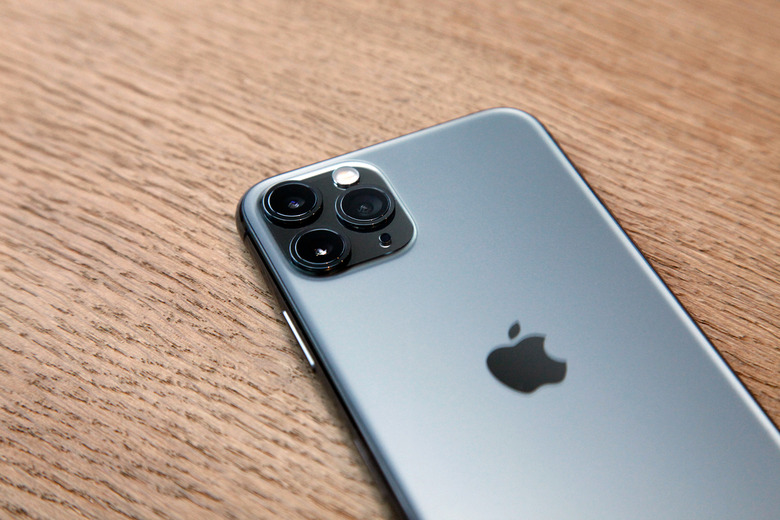Actually, The Crazy New Triple-Lens Camera Isn't The Best Thing About The iPhone 11 Pro
Up until a few short years ago, Apple had no rivals when it came to mobile cameras. In fact, no other smartphone maker even came close to matching the photo or video quality that Apple's iPhones were capable of achieving. If you go back a bit farther you may recall that early Android smartphones might as well not have even had cameras. Have you been around long enough to remember the uproar when Instagram first released its mobile app for Android back in 2012? It had long been an iPhone-only photo-sharing app, but Android was exploding in popularity and was a huge untapped market for the app, which was in the process of being acquired by Facebook. When the app was finally released for Google's mobile platform, however, iPhone users were absolutely disgusted. It seems insane when you look back on it, but their disgust was sort of understandable. The simple fact of the matter is that they were used to scrolling through a feed of stunning photos that were crisp and vibrant. Once the app arrived on Android phones, however, dull and blurry photos that looked like they have been captured in the 1800s began flooding their Instagram feeds.
It wouldn't be much longer before Android phone vendors finally realized how important mobile camera quality was, and they began to invest heavily in relevant R&D. Then, a few years ago, companies like Huawei, Google, and even Samsung actually managed to surpass the iPhone's camera quality by combining advanced camera sensors with smarter software processing. One of the reasons so many people are still talking about the iPhone 11 Pro and iPhone 11 Pro Max is because it finally marks Apple's retaking of the smartphone camera crown. After falling far behind Huawei in overall camera quality and even farther behind Google in low-light photo quality, the new triple-lens camera on the iPhone 11 Pro surpasses them both. It's a huge deal indeed, and it's fantastic for iPhone users who upgrade to one of Apple's latest and greatest smartphones. But believe it or not, the outstanding new camera on the iPhone 11 Pro series isn't even the best thing about Apple's latest flagship phones.
I picked up a new iPhone 11 Pro for myself last month on launch day, and I still can't believe how good the new triple-lens camera is. The most obvious and dramatic improvement is Night mode, which is Apple's take on a feature that Google created for its Pixel phone lineup. That's right, you have Google to thank for one of the iPhone 11's best new features.
By taking multiple images at various exposures and stitching them together behind the scenes, smartphones can now capture shockingly impressive photos in very low light. Google might've been the first to master the process on its smartphones, but there's precious little question that Apple's new iPhone 11 series does it better than any Pixel phone. In fact, even hardcore Android fans admit that Apple's Night mode blows Google's Night Sight out of the water.
Of course, Night mode is just one aspect of the new triple-lens camera system on Apple's iPhone 11 Pro and iPhone 11 Pro Max. There are plenty of other improvements across the board, and the addition of Deep Fusion in the latest iOS 13.2 beta makes photos even more crisp in medium lighting. But as good as the new cameras are on Apple's latest flagship iPhones, there's something even more impressive about them that has sort of flown under the radar.
Do some quick searching on Reddit, Twitter, Facebook, or other social media sites and you'll find plenty of talk about Apple's new iPhone cameras. But you'll also find something else that iPhone 11 Pro and iPhone 11 Pro Max owners are boasting about, and I would argue that it's an even better upgrade than the cameras. I'm talking about the battery life improvements, which are out of this world.
Apple said on stage when it announced its new iPhone 11 and iPhone 11 Pro smartphones were going to offer tremendous gains where battery life is concerned. The company said that the smaller iPhone 11 Pro adds 4 hours of usage time compared to last year's iPhone XS, and the larger iPhone 11 Pro Max adds a whopping 5 extra hours compared to the iPhone XS Max. Incredibly, those claims aren't exaggerations at all. Look around social media sites and you'll find that people are positively blown away by the battery life on these new iPhones. Personally, I find that I still have about 50% or even more battery remaining when I put my iPhone on the wireless charger beside my bed each night. Frankly, that is absolutely insane.
The new cameras on Apple's 2019 iPhone lineup will continue to be the most talked-about upgrade Apple introduced this year, and that's because you can see the improvements with your own eyes. The photo and video quality managed by the iPhone 11 series is indeed incredible, but it's the jaw-dropping battery life on the iPhone 11 Pro and iPhone 11 Pro Max that deserves even more praise.
